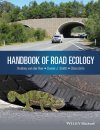By: Kimberly M Andrews(Editor), Priya Nanjappa(Editor), Seth PD Riley(Editor)
281 pages, 62 b/w photos, 33 b/w illustrations, tables
![Roads & Ecological Infrastructure Roads & Ecological Infrastructure]()
Click to have a closer look
About this book
Customer reviews
Biography
Related titles
Recommended titles
About this book
Few of us think twice about driving on roads. Yet the very presence of roads and the act of driving on them can impact the ecological infrastructure that supports an animal's daily life. What chance does a turtle have of successfully laying its eggs when it needs to traverse a busy highway? Is it realistic to expect small mammals to breed when an interstate thoroughfare subdivides their population? These are the sorts of challenges faced by small, often slow-moving, animals, challenges that road engineers and ecologists are trying to address.
For countless small species, vehicles traveling at high speeds are nothing less than missiles shooting across migration pathways. For too many animals, the danger can lead to the loss of populations, in part because they simply are not programmed to react to traffic. Salamanders faced with a two-lane road between the forest and their aquatic breeding site, for example, will typically cross that road regardless of the congestion. The result can be hundreds of flattened animals in a single night.
Roads and Ecological Infrastructure is the first book to focus on reducing conflict between roads and small animals. Highlighting habitat connections and the challenges and solutions from both transportation and ecological perspectives, Roads and Ecological Infrastructure covers various themes, including animal behavior related to roads and design approaches to mitigate the negative effects of roads on wildlife. The chapter authors – from transportation experts to university researchers – each promote a goal of realistic problem solving.
Conceptual and practical, Roads and Ecological Infrastructure will influence the next decade or more of road design in ecologically sensitive areas and should prevent countless unnecessary wildlife fatalities.
Customer Reviews
Biography
Kimberly M. Andrews is a wildlife researcher and graduate faculty member at the University of Georgia and the research coordinator at the Jekyll Island Authority.
Priya Nanjappa is the amphibian and reptile coordinator at the Association of Fish and Wildlife Agencies and a national coordinator for Partners in Amphibian and Reptile Conservation.
Seth P. D. Riley is a wildlife ecologist for the U.S. National Park Service. He is the coeditor of Urban Carnivores: Ecology, Conflict, and Conservation.
By: Kimberly M Andrews(Editor), Priya Nanjappa(Editor), Seth PD Riley(Editor)
281 pages, 62 b/w photos, 33 b/w illustrations, tables
"Managers have largely ignored small wildlife species when mitigating the impacts of roads and traffic. However, when considering nature conservation, smaller wildlife species – especially amphibians and reptiles – seem to be particularly vulnerable. This book synthesizes the impacts of roads and traffic on small wildlife species and presents strong recommendations to address these impacts. Read them and make good things happen!"
– Marcel Huijser, Western Transportation Institute, Montana State University







































